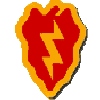

|
The scene is the little Vietnamese village of Ap Nhi, which stretched along the south side of Main Supply Route 22. It was a farming community, about half way between Go Dau Ha and Tay Ninh. The Ben Cui Rubber Plantation, known locally as the 'Little Rubber' is near the village. The weather and poor military planning favored the plans of our enemy, the Viet Cong, to ambush one of the U.S. supply convoys. It was the rainy season, with poor visibility, and a low ceiling making flying of helicopter gunships dangerous. Initially, there was no available artillery in range of the ambush to support the troops. There was great concern about the lack of resources to react to an enemy attack along the supply route. On the night of 24 August 1968, a reinforced Viet Cong battalion of five companies moved into the village, with the intent of ambushing the Tay Ninh supply convoy. The convoy had 81 trucks of the 48th Transportation Company, made up of Refer Trucks in front, then supply trucks, fuel trucks, and ammo trucks following. The enemy positioned four Viet Cong companies in the trench and rubber trees on the western edge of the 'Little Rubber' plantation. A fifth Viet Cong company occupied fighting positions in the village of Ap Nhi. At 11:45 hours, as the lead convoy trucks entered Ap Nhi it was misty and raining. The convoy was met by a column of Viet Cong dressed as ARVN (Army of the Republic of South Viet Nam) soldiers marching single file along the north side of the Main Supply Route adjacent to the Little Rubber plantation. As the lead trucks exited the village, the fuel and ammunition trucks, at the convoy's rear were in the enemy's ambush kill zone. The enemy troops opened fire. The initial shot of the ambush signaled the beginning of the assault. Almost immediately at least one fuel truck at the front of the kill zone was hit and exploded. The remainder of the convoy behind the burning fuel truck were trapped. The 31 trucks ahead of the fuel tanker truck escaped, but fifty were caught in the kill zone. Seconds later an ammunition trailer at the rear of the convoy was hit and burning, cooking off ammunition. In the initial attack, gun jeeps and vehicles with radios, were also disabled. Just as the column came to a halt, the enemy charged from the rubber trees. They fired automatic weapons, threw grenades, and were supported by machine gun, and rocket propelled grenade (RPG) fire in an attempt to overrun our convoy drivers and take control of their trucks. From hastily established firing positions, the truckers gallantly returned fire. At least seven American troops died in the initial engagement, and one of them - Sergeant William W. Seay - received a posthumous Medal of Honor. The Citation gives a sense of what occurred: "As the main elements of the convoy entered the ambush killing zone, they were struck by intense rocket, machinegun and automatic weapon fire from the well concealed and entrenched enemy force. When his convoy was forced to stop, SGT Seay immediately dismounted and took a defensive position behind the wheels of a vehicle loaded with high-explosive ammunition. As the violent North Vietnamese assault approached to within 10 meters of the road, SGT Seay opened fire, killing 2 of the enemy. He then spotted a sniper in a tree approximately 75 meters to his front and killed him. When an enemy grenade was thrown under an ammunition trailer near his position, without regard for his own safety he left his protective cover, exposing himself to intense enemy fire, picked up the grenade, and threw it back to the North Vietnamese position, killing 4 more of the enemy and saving the lives of the men around him. Another enemy grenade landed approximately 3 meters from SGT Seay's position. Again SGT Seay left his covered position and threw the armed grenade back upon the assaulting enemy. After returning to his position he was painfully wounded in the right wrist; however, SGT Seay continued to give encouragement and direction to his fellow soldiers. After moving to the relative cover of a shallow ditch, he detected 3 enemy soldiers who had penetrated the position and were preparing to fire on his comrades. Although weak from loss of blood and with his right hand immobilized, SGT Seay stood up and fired his rifle with his left hand, killing all 3 and saving the lives of the other men in his location. ... SGT Seay was mortally wounded by a sniper's bullet." US forces in the area responded rapidly and violently, with two infantry companies and an armored troop arriving on scene. The ambush became a day-long fight that ended after night fell. 19 US soldiers were killed in the incident and 3 were taken prisoner's of war. there were 11 killed from the convoy personnel and 8 from the reaction force. You can read a detailed first person accounting of the ambush here. They were Convoy personnel:
|
| Contact Us | Copyrightę 1997-2014 www.VirtualWall.org, Ltd «(TM) | Last update 09/09/2014 |